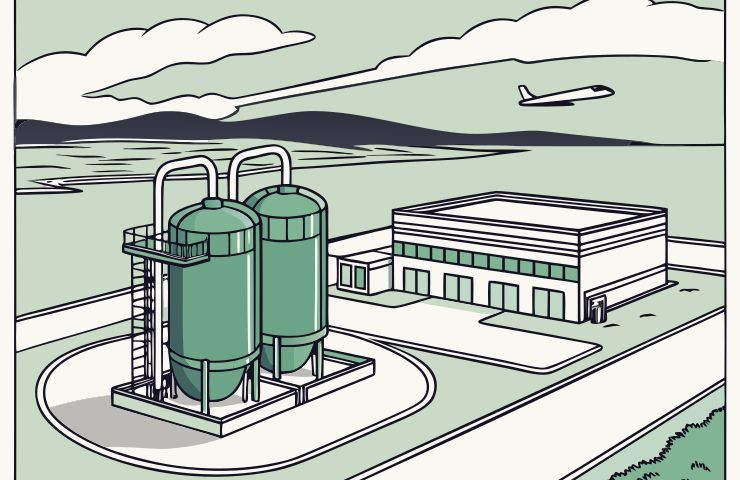
Hydrogen-Powered Airport Trial Debuts at Kirkwall Airport
October 30, 2025October 15, 2025 felt like any other crisp autumn morning in Orkney—until it wasn’t. Tucked among rolling green hills, EMEC quietly fired up its Hydrogen Combustion Engine system at Kirkwall Airport, running daily operations entirely on locally made Green Hydrogen. That’s right: a fully functioning Hydrogen-Powered Airport in the UK, no diesel in sight. This groundbreaking trial not only showcases how hydrogen can reshape airport infrastructure but also gives a hefty nudge toward Britain’s Net-Zero Aviation goals. It’s perfectly in step with Orkney’s bold promise to hit net-zero greenhouse gases by 2040—proof that these islands are still at the forefront of clean-energy innovation.
A Pioneering Trial in Orkney
Orkney’s reputation as a renewable-energy powerhouse didn’t happen overnight. Back in the 2000s, EMEC launched a world-class marine energy test site, putting tidal and wave devices through their paces. Before long, wind turbines peppered the archipelago, often cranking out more power than the islands could consume. That surplus sparked a smart idea: why not turn all that clean electricity into Green Hydrogen? By 2022, Orkney had one of the UK’s first public hydrogen refueling stations, and the trailblazing HyFlyer project even saw a retrofitted plane take flight on hydrogen-electric power.
Building on that momentum, EMEC stationed a container-sized test rig beside the runway at Kirkwall Airport. Instead of diesel generators, ground power units, lighting systems and service vehicles ran on hydrogen made just moments earlier by electrolysers powered by wind and tidal energy. The only exhaust was harmless water vapour drifting into the Scottish sky. It’s the UK’s first real-world shot at a Hydrogen-Powered Airport—proof that Orkney remains the ultimate living lab for sustainable energy.
How the Hydrogen Combustion Engine Works
What makes this approach so elegant is its simplicity. No exotic hardware, just clever tweaks to gear we already trust:
- Green hydrogen production: Electrolysers convert Orkney’s surplus renewable electricity into pure hydrogen and oxygen.
- High-pressure storage: That hydrogen is safely squeezed into sturdy cylinders fitted with leak detectors and relief valves.
- Engine conversion: A conventional internal-combustion engine gets a hydrogen retrofit—specialized injectors, reinforced cylinder heads to handle hydrogen’s fast flame, and extra cooling to prevent knock.
- Power output: The hydrogen burns, pistons fire, and a generator produces electricity for ground support equipment, runway lights and heating.
- Clean exhaust: Only water vapour leaves the tailpipe—no CO₂, no NOₓ, no soot.
In early trials, the engine ran non-stop for over 24 hours at full load, meeting peak ground-support demands without a hitch. That consistency builds serious confidence that hydrogen can handle the grind of around-the-clock airport operations.
Unlike fuel cells, these retrofits lean on familiar technology. Airports can trial hydrogen integration without overhauling everything. Smart control systems keep an eye on combustion and adjust fuel intake in real time, locking in efficiency and safety across a range of temperatures and loads.
Who’s Driving the Change?
This isn’t a one-man band. At the heart is EMEC, bringing two decades of experience in marine and hydrogen energy to lead engineering design, system integration and data analysis. HITRANS, the Highlands and Islands transport partnership, handles logistics and stakeholder outreach through the Sustainable Aviation Test Environment 2 (SATE2) program, funded with over £10 million from Innovate UK. Then there’s ZeroAvia, the Anglo-American specialist in hydrogen-electric powertrains, advising on fuel handling, engine mapping and safety certification. And, of course, Highlands and Islands Airports Limited (HIAL), which runs Kirkwall Airport, coordinated test scheduling and trained ground crews.
Alongside Innovate UK’s backing, EMEC and its partners invested in engine conversion and safety infrastructure, proving these projects can fit realistic budgets and timelines. Academic collaborators from the University of Strathclyde and Heriot-Watt University dove into emissions analysis and materials research to ensure engine longevity.
Meanwhile, the UK Civil Aviation Authority expanded its Hydrogen Challenge to include airport operations, smoothing the regulatory path. “Innovation thrives in Orkney because we can test in real operations,” says a HITRANS project lead. “SATE2 turns revolutionary concepts into ready-to-deploy solutions.”
What Are the Real-World Benefits?
This trial isn’t just a tech demo—it delivers tangible wins:
- Drastic emissions reduction: Swapping diesel for hydrogen cuts ground-operation CO₂ to zero and nearly eliminates particulate pollution.
- Energy security: On-site hydrogen production slashes reliance on imported fuels—critical for island communities.
- Cost insights: Real operational data helps airports compare lifetime costs of hydrogen systems versus diesel, guiding smarter investments.
- Job creation: New roles in electrolyser maintenance, high-pressure gas handling and hydrogen safety boost local employment.
- Regulatory progress: Live performance data feeds into CAA standards, accelerating approvals for future hydrogen deployments.
- Replication potential: Its modular, plug-and-play design means other regional airports can adopt similar setups without massive overhauls.
Beyond cleaner air, this project strengthens the local supply chain. Companies gain hands-on experience manufacturing storage components and managing complex integrations, positioning Orkney as Scotland’s—and the UK’s—go-to hydrogen hub.
Next Steps and Scaling Up
Buoyed by promising results, EMEC and partners are already mapping out what’s next:
- Extended testing: Rack up more engine hours through winter to prove reliability in harsh weather.
- Port integration: Adapt the system for harbour cranes and vessels, tapping into EMEC’s marine expertise.
- Broader rollout: Bring other regional airports in Scotland and northern England onboard, customizing modules for each site.
- Academic collaboration: Work with the University of Strathclyde to deep-dive into long-term performance data and refine engine-control algorithms.
- Policy engagement: Partner with Transport Scotland and the Department for Transport to shape supportive regulations and funding schemes.
Although aviation is the focus now, the same approach could power hospital backup systems, data centre generators or remote industrial sites—spreading the hydrogen revolution even further.
What Could This Mean for Aviation’s Zero-Emission Goals?
Could hydrogen not only run tarmac vehicles but entire aircraft? Trials like this lay the groundwork. By proving ground operations can hum along reliably and cleanly on Green Hydrogen, airports build the confidence, infrastructure and regulatory framework needed for hydrogen-powered flights.
As EMEC’s managing director puts it, “This demonstration is a significant step toward decarbonising every part of air travel.” With Scotland aiming for Net-Zero Aviation by 2040 and the UK government backing hydrogen tech, Orkney’s success offers a blueprint for major hubs worldwide. Imagine future airports blending hydrogen combustion for ground power with fuel cells for emergency and onboard use—creating fully integrated zero-emission ecosystems.
The pressure to decarbonise aviation is sky-high. If more airports adopt Orkney’s model, diesel might soon be a thing of the past. For travellers, the racket and fumes of traditional ground vehicles could give way to whisper-quiet, steam-like plumes—tiny glimpses of a cleaner, hydrogen-powered future.



 With over 15 years of reporting hydrogen news, we are your premier source for the latest updates and insights in hydrogen and renewable energy.
With over 15 years of reporting hydrogen news, we are your premier source for the latest updates and insights in hydrogen and renewable energy.
Doesn’t burning hydrogen in air (with N and O) create NOx?